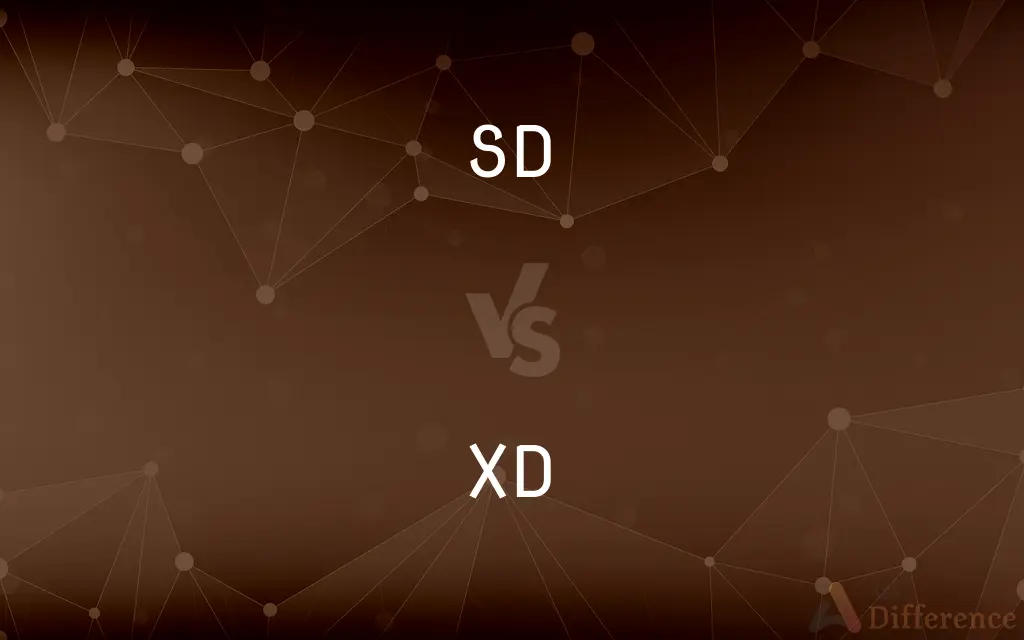SD vs. XD — What's the Difference?
Edited by Tayyaba Rehman — By Urooj Arif — Published on August 4, 2024
SD (Secure Digital) cards are widely used memory storage formats, while XD (Extreme Digital) cards were a specific type of flash memory card designed for digital cameras.

Difference Between SD and XD
Table of Contents
ADVERTISEMENT
Key Differences
SD cards, or Secure Digital cards, are a universal storage format used in a wide range of digital devices, including cameras, smartphones, and laptops. They come in various sizes and capacities, offering flexibility and compatibility across many devices. xD-Picture Cards (xD), on the other hand, were specifically developed for use in digital cameras by Olympus and Fujifilm. xD cards are now largely obsolete, having been phased out in favor of SD cards due to their wider compatibility and capacity options.
SD cards offer a broad range of storage capacities, from a few megabytes to several terabytes, and they come in three main sizes: SD, miniSD, and microSD, with microSD cards being the most popular due to their compact size. xD cards were limited in both capacity and size, typically maxing out at 2GB, which constrained their use as high-resolution digital photography advanced.
In terms of compatibility, SD cards have a clear advantage. They are supported by an extensive array of devices beyond just digital cameras, including drones, gaming consoles, and more. This universal support has contributed to their popularity and continued development. xD cards suffered from limited device compatibility, mainly confined to certain models of Olympus and Fujifilm cameras, which ultimately contributed to their decline.
Performance-wise, SD cards also have the edge, with newer models supporting high-speed data transfer rates that accommodate 4K video recording and rapid burst photography. While xD cards provided sufficient performance for photography during their peak usage, they couldn't keep up with the increasing data demands of modern digital media.
Despite the decline of xD cards, they played a crucial role in the development of digital photography, offering a compact and efficient storage solution at the time. However, the versatility, capacity, and speed of SD cards have made them the preferred choice for digital storage needs across a wide spectrum of technologies.
ADVERTISEMENT
Comparison Chart
Usage
Broad (cameras, phones, laptops, etc.)
Limited (mainly Olympus & Fujifilm cameras)
Storage Capacity
Up to several TB
Up to 2GB
Sizes
SD, miniSD, microSD
One standard size
Compatibility
Extensive across many devices
Restricted to specific camera models
Performance
High-speed data transfer, supports 4K video
Sufficient for standard photography
Current Relevance
Widely used and developed
Largely obsolete
Compare with Definitions
SD
A universal flash memory card format.
Used in Android smartphones for extra storage.
XD
Became obsolete as technology advanced.
Replaced by SD cards in newer camera models.
SD
Continues to evolve with technology.
SDXC cards for high-capacity storage needs.
XD
Lacked the versatility of SD cards.
Incompatible with non-Olympus or Fujifilm devices.
SD
Widely compatible with various devices.
Expanding storage on a Nintendo Switch.
XD
Limited to 2GB storage capacity.
Storing photos on a 1GB xD card.
SD
Available in multiple capacities and sizes.
A 64GB microSD card in a drone.
XD
A flash memory card for digital cameras.
Used in older Fujifilm digital cameras.
SD
Supports high-speed data transfer.
Recording 4K video on an action camera.
XD
Played a role in early digital photography.
Enabled compact storage solutions for cameras.
SD
Alternative case form of SD, standard deviation
Common Curiosities
Why did xD cards become obsolete?
Limited capacity, device compatibility, and the rise of the more versatile SD card format led to the obsolescence of xD cards.
What does it mean when an SD card is labeled as SDHC or SDXC?
SDHC (Secure Digital High Capacity) supports cards up to 32GB, while SDXC (Secure Digital eXtended Capacity) supports cards from 32GB up to 2TB.
Can I recover data from an old xD card?
Yes, with the right card reader and software, it's possible to recover data from xD cards, similar to other types of flash memory.
Why are microSD cards more popular than miniSD cards?
MicroSD cards offer a compact size with large storage capacity, making them ideal for mobile devices, where space is limited.
Can I use an SD card in a device that requires an xD card?
Generally, no, unless the device specifically supports both formats or an adapter is used, which is rare.
Are all SD cards the same speed?
No, SD cards vary in speed, classified under different classes (Class 2, 4, 6, 10, UHS, etc.) indicating their minimum performance.
Is there a significant price difference between SD and xD cards?
As xD cards are largely obsolete, they may be harder to find and potentially more expensive due to their rarity, whereas SD cards are widely available and competitively priced.
What are the environmental impacts of disposing of old xD or SD cards?
Like all electronic waste, improper disposal can lead to harmful environmental impacts. Recycling or proper e-waste disposal methods are recommended.
How has the evolution of SD cards impacted digital photography?
The increasing capacity and speed of SD cards have greatly enhanced the capabilities of digital cameras, supporting higher resolution images and video.
How do I choose the right SD card for my device?
Consider the device's supported SD card type, capacity needs, and performance requirements, such as speed class for video recording or app performance.
Share Your Discovery

Previous Comparison
Cold vs. Flu
Next Comparison
AC Power vs. DC PowerAuthor Spotlight
Written by
Urooj ArifUrooj is a skilled content writer at Ask Difference, known for her exceptional ability to simplify complex topics into engaging and informative content. With a passion for research and a flair for clear, concise writing, she consistently delivers articles that resonate with our diverse audience.
Edited by
Tayyaba RehmanTayyaba Rehman is a distinguished writer, currently serving as a primary contributor to askdifference.com. As a researcher in semantics and etymology, Tayyaba's passion for the complexity of languages and their distinctions has found a perfect home on the platform. Tayyaba delves into the intricacies of language, distinguishing between commonly confused words and phrases, thereby providing clarity for readers worldwide.













































